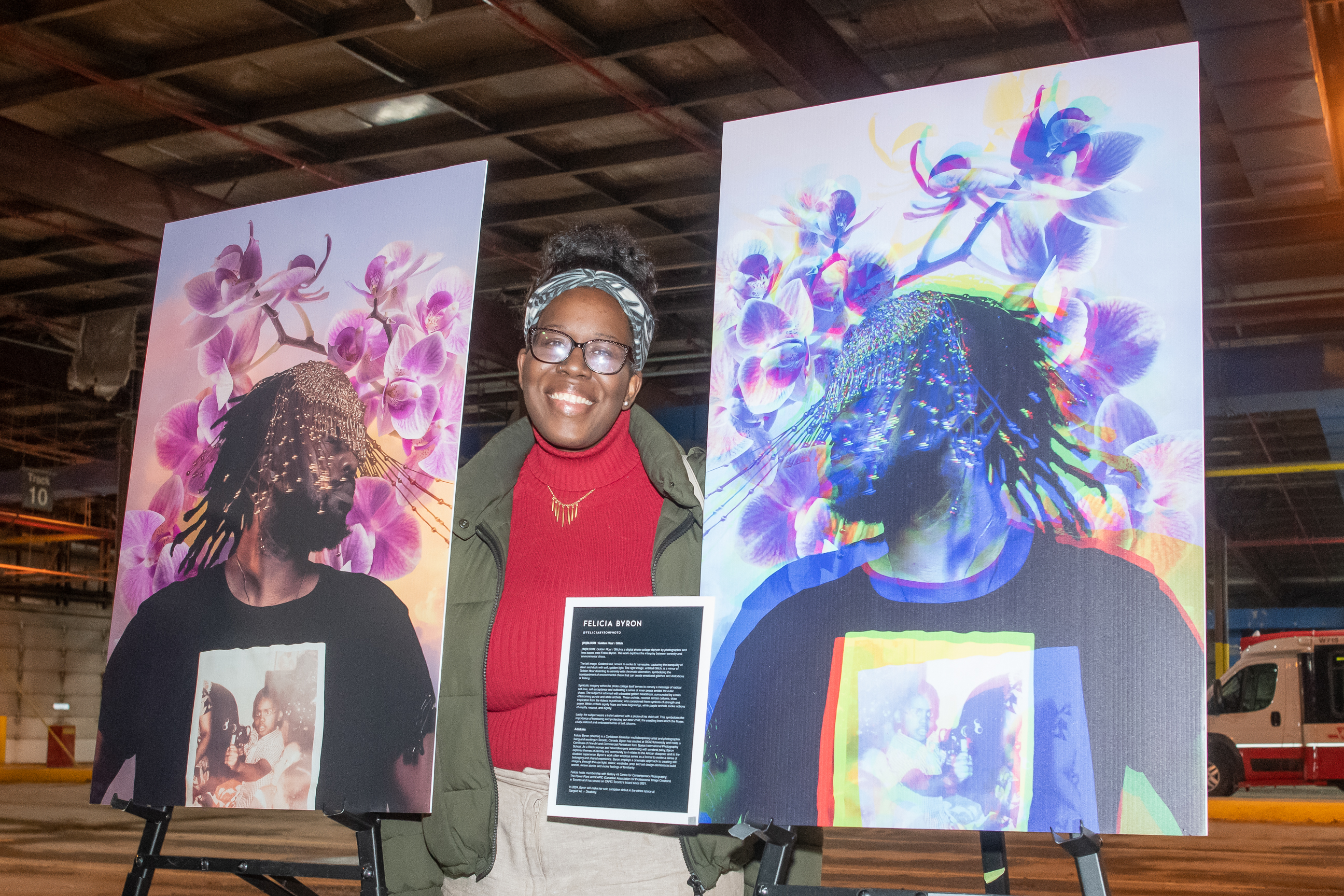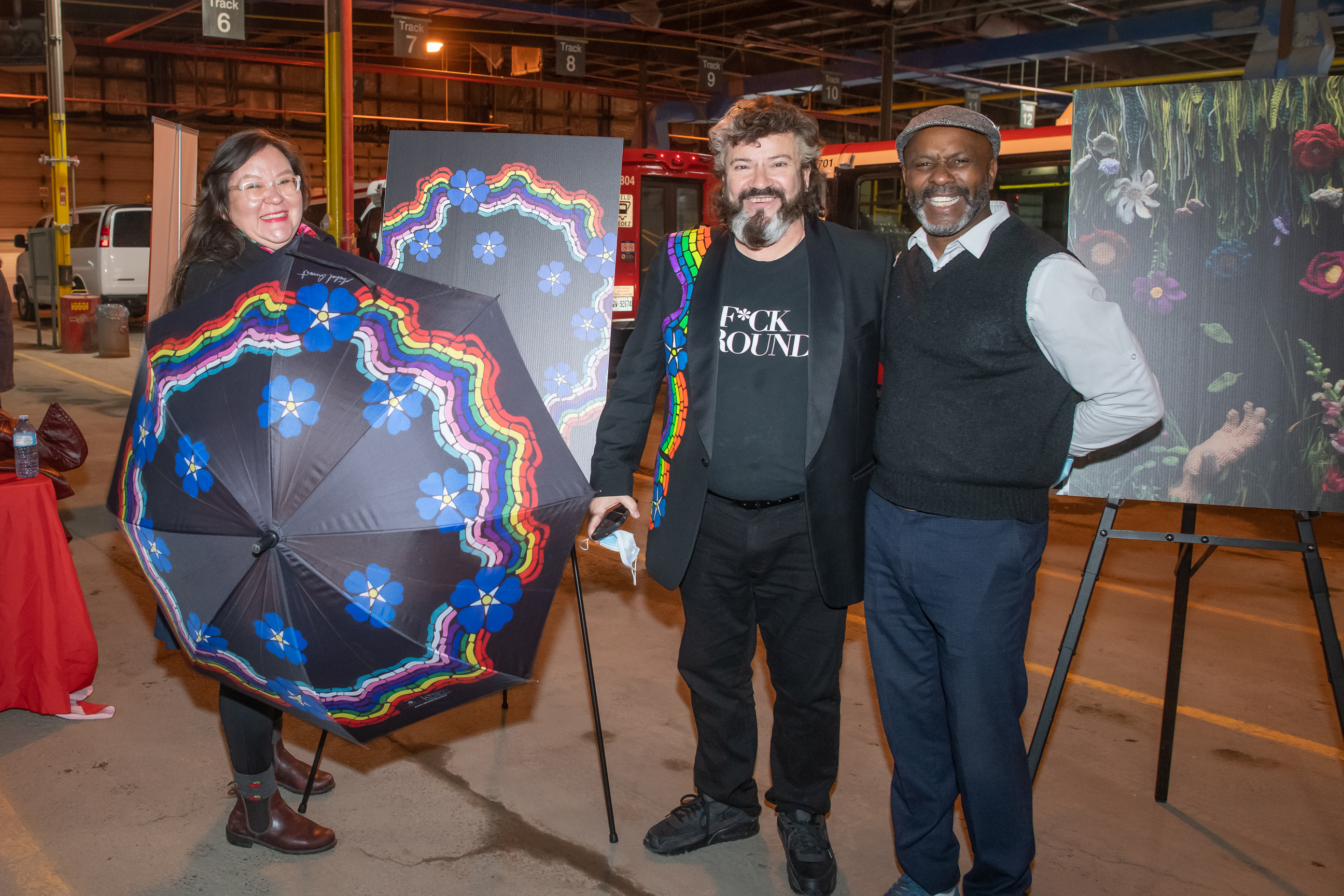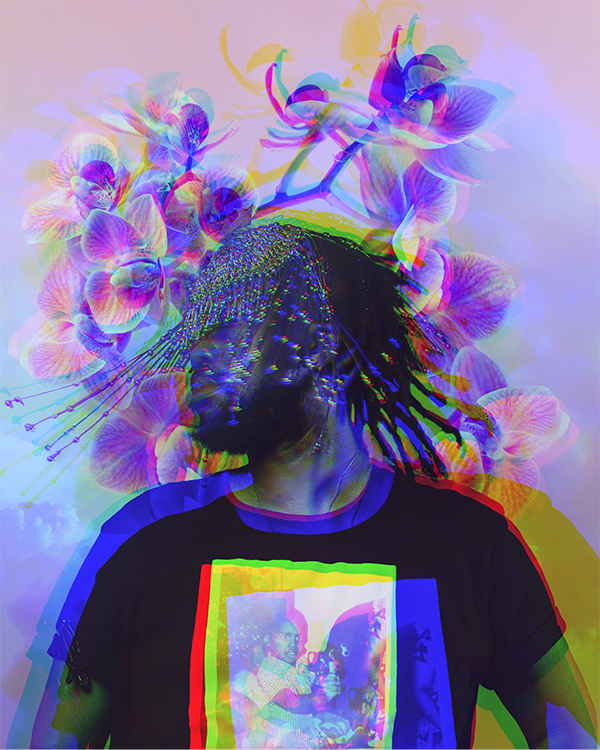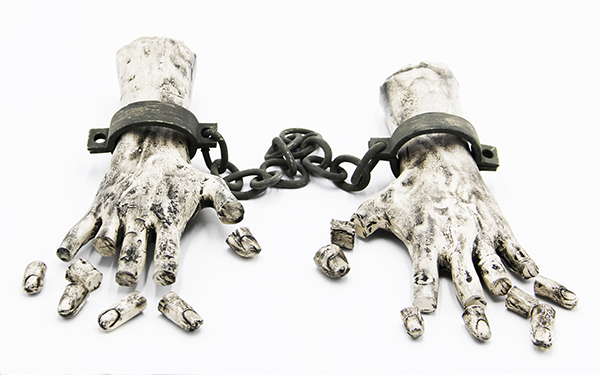TTC celebrating Black, Indigenous and Racialized artists
-
Launch Event







To mark International Day of Persons with Disabilities on December 3, 2023, the TTC has partnered with Tangled Art + Disability, a not-for-profit art + disability organization, to showcase works by eight artists. Their artwork can be seen on two Wheel-Trans vehicles, as well as on select subway trains on Lines 1, 2 and 4, until the end of January 2024.
Read the exhibition statement below, or watch this video of Gaitrie Persaud who is making ASL translation of the exhibition statement for Transit as a canvas.
-
Transit as a canvas
“Disabled people do not seek merely to participate in culture--we want to create it, shape it, and stretch it beyond its tidy edges.”
Catherine Frazee (2009, as cited in Chandler et al., 2018).
As riders of the TTC, we all know the discomfort of having our routes disrupted. Today, we invite you to experience disruption as something desirable. With Transit as a canvas, we aim to disrupt systems that prevent disabled people from flourishing.
Transit as a canvas celebrates eight artists from our Mad, d/Deaf and Disability communities who have contributed their creative brilliance and personal narratives to transform the space of the TTC into a celebration of disability art and culture.
This initiative showcases a vibrant community of Mad, d/Deaf, Disabled, sick, spoonie, neurodivergent, and chronically ill artists who are demanding recognition and space within the arts. Transit as a canvas provides a powerful platform for our artists to transform everyday public spaces into canvases that celebrate their experiences. These pieces are more than a showcase of their artistic journeys; they are political interventions that point toward a future where disability is cherished and celebrated.
Felicia Byron, Vanessa Dion Fletcher, Michel Dumont, Maryam Hafizirad, Peter Owusu-Ansah, Cleopatria Peterson, Sarah Dawn Richardson, and Gloria C. Swain all push the boundaries with a political intent to disrupt conventional notions of art, disability, and the potential of the human body. With their distinct artistic backgrounds, a common thread runs through all of the art. Each piece explores different parts of disabled lived experience, the pursuit of a more accessible world, and the dreamings of intersectional disabled and crip futures.
The Transit as a canvas project celebrates how disability can offer new ways to experience the world by disrupting what society tells us about disability. We would love for you to think of disability differently as you engage with the artworks in this project that are unapologetically “crip” and reclaim disability as joyous disruption.
ABOUT
Tangled Art + Disability is a disability-led arts organization working towards creating more accessible opportunities in the arts. Our mandate is to support d/Deaf, Mad and Disabled artists, to cultivate disability arts in Canada, and increase access to the arts for everyone. Transit as a Canvas is a collaboration between Tangled Art + Disability and the TTC.
Citation
Chandler, E., Changfoot, N., Rice, C., LaMarre, A., & Mykitiuk, R. (2018). Cultivating Disability Arts in Ontario. The Review of Education/Pedagogy/Cultural Studies, 40(3), 249–264.


Listen to the audio description of the artwork by the artist
[IN]BLOOM: Golden Hour / Glitch is a digital photo collage diptych by photographer and lens-based artist Felicia Byron. This work explores the interplay between serenity and environmental chaos. The left image, Golden Hour, serves to evoke its namesake, capturing the tranquility of dawn and dusk with soft, golden light. The right image, entitled Glitch, is a mirror of Golden Hour distorting its serenity with chromatic aberration, symbolizing the bombardment of environmental chaos that can create emotional glitches and distortions of feeling. Symbolic imagery within the photo collage itself serves to convey a message of radical self-love, self-acceptance and cultivating a sense of inner peace amidst the outer chaos. The subject is adorned with a beaded golden headdress, surrounded by a halo of blooming purple and white orchids. These orchids, revered across cultures, draw inspiration from the Aztecs in particular, who considered them symbols of strength and power. White orchids signify hope and new beginnings, while purple orchids evoke notions of royalty, respect, and dignity. Lastly, the subject wears a t-shirt adorned with a photo of his child self. This symbolizes the importance of honouring and protecting our inner child; the seedling from which the flower, a fully realized and embraced sense of self, blooms.
Artist biography
Felicia Byron (she/her) is a Caribbean-Canadian multidisciplinary artist and photographer living and working in Toronto. Byron has studied at OCAD University and holds a Certificate of Fine Art and Commercial Portraiture from Spéos International Photography School. As a Black woman and neurodivergent artist living with cerebral palsy, Byron explores themes of identity and community as it relates to the African diasporic and to the disabled experience. Byron’s work often employs series as a format to evoke a sense of belonging and shared experience. Byron employs a cinematic approach to creating still imagery, through the use light, colour, wardrobe, prop and set design elements to build worlds, weave stories and evoke feelings of familiarity. Felicia holds membership with Gallery 44 Centre for Contemporary Photography, The Power Plant and CAPIC (Canadian Association for Professional Image Creators) in Toronto and has served on CAPIC Toronto’s board since 2021. In 2024, Byron will make her solo exhibition debut in the vitrine space at Tangled Art + Disability.
Michel Dumont

Listen to the audio description of the artwork by the artist.
My Forget Me Not River of Pride is inspired by ribbon skirts and shirts, crafted during my time as the 2022 Indigenous artist-in-residence at Allan Gardens with Toronto Metropolitan University. Following years of canceled Pride marches, during my residency, which was at the terminus of the Women’s Pride March, I heard something that I had hadn’t heard for years: the joyous cheering of thousands of women— akin to a river of celebration. Incorporating the iconic blue Forget Me Not pattern, a Métis design found in beadwork and Ojibway satin appliqué, my work weaves together the intricate elements of my identity as a Two-Spirit individual navigating the urban landscape of a queer Turtle Island. This piece serves as a testament to the importance of our visibility, reminding us that the preservation of our rights hinges upon our voices resonating through the tapestry of our shared experiences. Just as each mosaic piece is unique, we are stronger when we come together to celebrate our differences and march together, flowing like of a river of Pride.
Artist biography
Michel Dumont is a queer, Métis, Two-Spirit, disabled artist and trauma survivor who enjoys breathing new life into discarded vintage tile by turning it into striking mosaic pieces. Working with shattered tile mirrors the day-to-day reality of living with a shattered spine, striving to make something beautiful out of the experience. A self-taught artist and community mentor, his mediums also include unconventional materials for wearable art. Making outfits for the drag community with non-toxic cellophane allowed him to continue working after developing multiple chemical sensitivity in 2015. Also known as Environmental Sensitivity, MCS is an auto-immune disorder affecting over a million Canadians causing mild to debilitating allergies to scent, smoke, glues, plastics, and/or any off-gassing materials. Creating art daily helps Michel cope with the effects of decades of chronic pain, anxiety and PTSD. As a son of an Indian day school survivor, he honours his culture in his work.



Listen to the audio description of the artwork by the artist.
Artist biography
Vanessa Dion Fletcher is a Lenape and Potawatomi neurodiverse artist; her family is from Eelūnaapèewii Lahkèewiitt (displaced from Lenapehoking) and European settlers. She uses porcupine quills, Wampum belts, and menstrual blood to reveal the complexities of what defines a body physically and culturally. Reflecting on an Indigenous and gendered body with a neurodiverse mind, Dion Fletcher primarily works in performance, textiles and video. She graduated from The School of the Art Institute of Chicago in 2016 with an MFA in performance and a Bachelor of Fine Arts from York University in 2009. She has exhibited across Canada and the USA at Art Mur Montreal, Eastern Edge Gallery Newfoundland, The Queer Arts Festival Vancouver and the Satellite Art show in Miami. Her work is in the Indigenous Art Centre, Joan Flasch Artist Book Collection, Vtape, Seneca College, Global Affairs Canada and the Archives of American Art.


Mother of De’VIA – Seeds from Within honours Betty G. Miller (1934-2012), “Mother of the Deaf View Image Art (De’VIA)” movement. She was the first to emphasize bold graphic depictions of sign language oppression and later began painting colourful affirmations of the beauty of sign language. Her Deaf resistance art in the early 1970s was revolutionary and a precursor to the eventual De’VIA Manifesto, which she and her colleagues articulated in 1989. Miller represents the Deaf culture ancestral seeds that grow within. This sculpture pays homage to her famous ink painting, AMESLAN (American Sign Language [ASL7) Prohibited (1972), and celebrates the beauty of ASL painted in the renowned acrylic, Growing with ASL (1992). She sculpted two roughly textured black and white handcuffed hands tied together by wire with fingertips broken off – like a withering plant. It is juxtaposed with a contrasting colourful sculpture series – symbolic of the sign “grow” with a progression of three vibrantly glazed hands emerging well-nourished – then watered by golden hands. ASL, “as good as gold,” like the air we breathe and the watering of plants, gives us life, with ASL we flourish.
Artist biography
Maryam Hafizirad is a Deaf Canadian Persian painter and sculptor. A graduate of Isfahan University of Fine Arts (Iran) with her first exhibition at the age of 18, her award-winning exhibitions have been featured in Iran, China, Germany, Malaysia, India and Canada. Hafizirad’s early works referenced classical Persian art, where women’s faces and bodies were forbidden to be represented. When she moved to Malaysia and later settled in Canada, her work transformed and she moved away from this dark subject matter. She began painting bright Persian-inspired and De’VIA meteaphors (acrylic, crushed coloured glass and watercolour), pomegranates (symbols of hidden love released), fish in water (sincere human beings in her silent world of pure beauty) and birds (embodying her new found freedom in this country). More recently, her work fuses these symbols in large mixed-media installations with ceramic, colourful, glazed sculptures, handshapes and large eyes, affirming her Deaf identity, graceful language and quiet strength.

Listen to the audio description of the artwork by the artist.
It’s Fall 2022 is colourful concentric squares. This piece focuses on my relationship with yellow/orange as a background or environment. How do I sense myself? After creating many of them with intention to capture myself in that specific colours. I found my loving sunrise or sunset hit in the earlier autumn leaves. There are some green, some yellow, green orange, red and gold. These are put in squares create a kind of tunnel or landscape that I always felt I want to see.
Artist biography
Peter Owusu-Ansah is self-motivated, Deaf visual artist. His colourful square works are an investigation of who he is. He uses photoshop to create endless colours. interactive possibilities and captures his pure joy. He uses the joy he captures not just to advocate for himself but also to help promote inclusion toward Deaf and Disabled artists and communities that are excluded in the art world. His works have been shown around Canada. Peter won the Murray and Marvelle Koffler Founder’s Award of the Toronto Outdoor Art Fair in 2021.

Listen to the audio description of the artwork by the artist.
This is the first drawing from the Cleopatria’s comic Returning, Returning, Returning. An intricate and derailed illustration playing with the cycles of nature, growth, and rebirth.
Artist biography
Cleopatria Peterson is a multidisciplinary artist and educator that writes, printmakes, illustrates and loves self-publishing. Their work focuses on themes of nature, humour, identity and above all things, love. They are the medal-winner for their thesis work in the Publications program at OCAD. Their work has been shown at Xpace, Open Studio, Fort York, The Textile Museum of Canada and abroad at Zygote Press.

Listen to the audio description of the artwork by the artist.
The main theme in this piece is that sense of not belonging in the world you were born into. Two sides that mirror each other but aren’t quite the same, and the longing to be a part of a world that is like you. This piece is a reflection on the experience of those who have been “othered” by a society which refuses to make space for them.
Artist biography
Sarah Dawn Richardson is a 29 year old queer artist from Hamilton, Ontario, where she resides today. Sarah uses yarn, fabrics, and beading mixed with biological components such as plants, mould, and microscopic fauna to create visually diverse pieces. Main themes found in her work are feminism, belonging, identity, and the idea of ‘otherness’ within a group.
Gloria C. Swain

Listen to the audio description of the artwork by the artist.
[un]SEEN, a personal piece of work from my Black Hair collection, is a mixed-media painting using acrylic paint, spray paint and soil on a 24" x 24" canvas to illuminate the connection between Black hair and untold stories that have erased Black women throughout history. Using soil for the textured hair symbolizes the connection of stolen Black women from ancestral land only to reproduce more Black bodies, the disrespect to our bodies, and the ongoing fight against racism and inequality today.
Artist biography
Gloria C Swain began creating art at an early age to overcome childhood trauma. Gloria makes work “to open dialogue about ongoing colonial violence against Black bodies and stigmas about Black mental health.” Swain is an inspirational multidisciplinary activist artist, with a practice that includes painting, performance, writing, and photography. Swain is also a seniors’ rights and mental-health advocate and holds a master’s degree in Environmental Studies. Gloria writes on disability arts advocacy, has exhibited work across Canada, and was the 2016 artist-in-residence at Tangled Art + Disability.